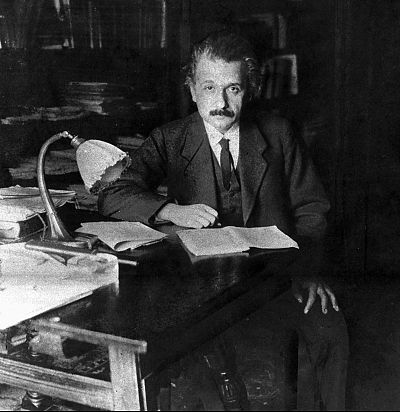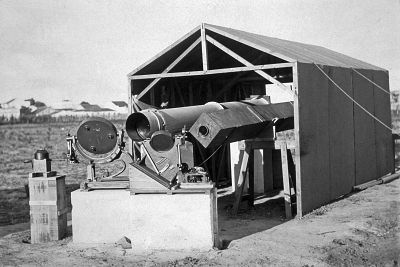When the moon blotted out the sun on May 29, 1919, scientists were able to confirm the physicist's theory of relativity.
One hundred years ago this week, a total solar eclipse briefly blotted out the sun and gave humanity a new understanding of the universe.
It was May 29, 1919, and English scientists were set to use the eclipse to test a revolutionary new theory of gravity known as general relativity — the brainchild of the not-yet-famous Albert Einstein. Relativity is now known as "one of the greatest achievements in human thought," as Nobel-winning physicist J.J. Thompson called it later that year. But until the 1919 eclipse, relativity — which Einstein had presented in 1915 — was still unproven.
After months of preparation, Arthur Eddington, director of the Cambridge Observatory, had his telescopes and photographic equipment set up on the island of Principe, off the west coast of Africa. Another astronomer, Andrew Crommelin of the Royal Greenwich Observatory, had his gear in place in the Brazilian town of Sobral.
It wasn't at all clear that the astronomers would succeed. Bad luck had stymied two earlier attempts to test Einstein's theory. Weather got in the way of a test during a 1912 eclipse; two years later, plans for another test were scuttled by the outbreak of the First World War. But in May of 1919, the war was over and astronomers were hopeful that at last they would be able to see if Einstein was right.
A new conception of space, time and gravity
For more than two centuries, gravity had been viewed the way Isaac Newton viewed it — as an attractive force between objects. But in 1915 Einstein had offered a new explanation for gravity, describing it not as a force but as a curvature of space caused by the presence of massive objects, including stars and planets.
That's a bit hard to picture, but Einstein and his colleagues realized that if the theory was correct, it would have a simple, measurable effect: Gravity would shift the path of a beam of light by a tiny amount.
We tend to think of light as perfectly weightless, but it's not quite that simple. Light is a form of energy, and Einstein showed in his famous equation E=mc2 of 1905 that energy can behave like mass. That new understanding, plus Einstein's discovery of curved space, meant that a beam of light should bend — that is, follow a curved rather than straight path — in response to gravity.
Any mass — a bowling ball, a mountain, the Earth — will bend a beam of light. But the astronomers knew that the deflection of light is proportional to the the mass of the object causing the deflection. To measure the tiny deflection, they needed something truly, colossally massive — something like our sun.
Imagine a beam of light speeding our way from a distant star, passing the sun on its path to Earth. As the light zooms past the sun, the sun's gravity ought to bend the beam's path, causing the star's apparent position to be shifted by a small amount.
Space
"Einstein made this very insightful observation — that light ought to be affected by gravity," says Daniel Kennefick, an astrophysicist and historian of science at the University of Arkansas in Fayetteville. That means that a beam of light will be deflected by a small amount, "and we ought to be able to measure this deflection."
Making such a measurement is tricky. Most of the time the sun is so bright that it's impossible to observe stars that lie near it in the sky. But for a few minutes during a solar eclipse, the moon blots out the sun's light, the background stars can be photographed and their positions can be pinpointed.
Of course, total solar eclipses are rare, happening only about once a year and visible only along a narrow band on Earth's surface. Complicating things is the fact that Einstein's theory predicts only a tiny shift of starlight — comparable to the width of a nickel viewed from a mile away. Telescopes and photographic plates of the era were just barely capable of detecting such a small shift.
"Through cloud. Hopeful."
Simply getting to the sites to view the 1919 eclipse was no easy matter, says Kennefick, whose new book, "No Shadow of a Doubt," tells the story of this crucial test of Einstein's theory. Back then, it took at least a year to organize an eclipse expedition, and no one knew how long the war would drag on. In November of 1918 — six months before the eclipse — Eddigton and Crommelin "were on the verge of calling it off," Kennefick says. "Had the war not ended a week later, they probably would have given up."
In the end, the weather was mixed. Skies at Sobral were clear. But Principe was covered by clouds, which cleared just long enough for Eddington's team to obtain a few photographs before the eclipse ended.
Eddington sent a three-word telegram to his colleagues back in London: "Through cloud. Hopeful."
After the eclipse was over and the astronomers had returned home, it took them months to measure the precise positions of the stars visible on the photographic plates. In the end, they concluded that the starlight was indeed shifted — and by an amount consistent with Einstein's theory.
England's Astronomer Royal, Frank Dyson, presented the results at a joint meeting of the Royal Astronomical Society and the Royal Society held on November 6, 1919 in London. Dyson said "there can be no doubt" that the eclipse measurements "confirm Einstein's prediction."
Einstein becomes a celebrity
The London Times reported the news the next day and the New York Times a couple of days later — and Einstein shot to worldwide fame. And despite the head-scratching complexity of general relativity, the confirmation of Einstein's theory resonated with millions around the world.
"Here was this remarkable news, that all of a sudden Newton's theory was being overthrown, to be replaced by a theory from this guy [Einstein] that they've never heard of," Kennefick says. "And the theory was said to be so brilliant that few people could understand it. That was, I think, very dramatic for people."
Indeed, people seemed to latch on to the theory despite — or perhaps because of — its complexity.
"General relativity was the poster child for being a crazy, new, hard-to-understand theory, with dramatic implications for the nature of reality," says Caltech physicist Sean Carroll. "And yet you could see [the results]; you could photograph it. So people got caught up in that excitement."
Over the years, historians have questioned whether the results of the 1919 test had been reported accurately. Some have argued that Eddington, in particular, was so eager to prove Einstein correct that he cleaned up the data — or perhaps even omitted data points that didn't seem to fit. But Kennefick says subsequent analysis of the observational data obtained in 1919 confirmed the original finding — and that Einstein's theory did, in fact, pass its great test.
Relativity has been confirmed dozens of times in the ensuing decades, with much greater accuracy — and has led to the discovery of other mind-bending wonders, including black holes and gravitational waves.
Want more stories about space?
- New Hubble Space Telescope photo is a 'living history book' of our universe
- Scientists finally solve the mystery of weird aurora-like lights in the sky
- Mystery of moon's formation may have been solved
SIGN UP FOR THE MACH NEWSLETTER AND FOLLOW NBC NEWS MACH ON TWITTER, FACEBOOK, AND INSTAGRAM.













